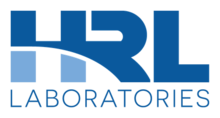HRL Laboratories
HRL Laboratories (formerly Hughes Research Laboratories) is a research center in Malibu, California, established in 1960. Formerly the research arm of Hughes Aircraft, HRL is currently owned by General Motors Corporation and Boeing. The research facility is housed in two large, white multi-story buildings overlooking the Pacific Ocean.
 | |
Formerly | Hughes Research Laboratories |
|---|---|
| Founded | Culver City, CA 1940s |
| Founder | Howard Hughes |
| Headquarters | 34.04292°N 118.69577°W, , |
| Parent | General Motors Company and Boeing |
| Website | www |
History
In the 1940s, Howard Hughes created a R&D facility in Culver City, California.
In 1984 the U.S. Federal Courts declared in a court case that the Howard Hughes Medical Institute, in order to retain its non-profit status, must divest itself of Hughes Aircraft Company and subsidiaries.
In 1959 construction started on the headquarters located on a Malibu hilltop overlooking the Pacific Ocean. The modernist white and glass building was designed by Los Angeles architect Ernest Lee. The headquarters was built by the Del E. Webb Construction Company, who built several facilities for Hughes. The laboratory opened in 1960.[1] In 1970 the Webb Construction Company built the second building.[2] General Motors purchased Hughes Aircraft in 1985.[3]
GM sold the Hughes aerospace and defense operations to Raytheon in 1997, and spun off Hughes Research Laboratories (legally renamed "HRL Laboratories, LLC"), with GM and Raytheon as co-owners. GM sold the Hughes satellite operations to Boeing in 2000, and the co-owners became Boeing, GM, and Raytheon. In 2007, Raytheon decided to sell its stake, though it still maintains research and contractual relations with HRL. For more details, please see Hughes Aircraft. HRL receives funding from its LLC partners, US government contracts, and other commercial customers.
HRL focuses on advanced developments in microelectronics, information & systems sciences, materials, sensors, and photonics; their workspace spans from basic research to product delivery. It has particularly emphasized capabilities in high performance integrated circuits, high power lasers, antennas, networking, and smart materials.
Despite downsizing during the aerospace industry's contraction of the 1990s, HRL still continued to be the largest employer in Malibu.
Notable accomplishments
- The first working model of the laser was created at Hughes Research Laboratories in 1960 by Theodore Maiman (1927–2007).
- HRL began research on atomic clocks in 1959. In the late 1970s they produced experimental maser oscillators for NRL, which eventually led to space-based GPS atomic clocks.
- HRL began research on ion propulsion in 1960.[4] This research led to the Hughes developed xenon ion propulsion system (XIPS. XIPS was used as the primary propulsion system on NASA's Deep Space 1 (launched in 1998). It is a standard option for primary stationkeeping on the Hughes/Boeing 601HP (first use: PAS-5, 1997) and the 702 (first use: Galaxy-XI, 1999) geostationary satellite families.
- HRL claims to have developed the liquid crystal watch in 1975.
- HRL's SyNAPSE neuromorphic chip is the first chip to learn like the brain by altering synapses (listed as one of MIT Tech Review top ten breakthrough technologies) (2010s).
- Developed world's largest most biologically accurate, integrated computational model of 9 brain systems explaining cognitive biases (2010s).
- CNN Top Ten DARPA Technologies (Cognitive Technology Threat Warning System), the world's first "cognitive-neural" binocular threat-detection technology (2010s)
- Developed "MagicNet," a pattern matching method using time-delay neural networks that is two times faster than deterministic finite automata for exact pattern matching[5] (2011).
- Designed and built reconfigurable spatially immersive display system (1990s).
- First hybrid satellite-wireless ad hoc network (1990s)
- First stabilized outdoor augmented reality system (1990s).
- HRL developed the metallic microlattice, the lightest material, in 2011[6]
References
- "Webb Spinner 1959-1960" (PDF).
- "Webb Spinner 1969-1970" (PDF).
- Cole, Robert J. (1985-06-06). "G.m. to Acquire Hughes Aircraft in $5 Billion Bid". The New York Times. ISSN 0362-4331. Retrieved 2020-06-08.
- "Ion Propulsion – Over 50 Years in the Making". NASA. Archived from the original on 2014-01-31.
- H. Hoffmann, M. D. Howard, and M. J. Daily (2011). "Fast pattern matching with time-delay neural networks". International Joint Conference on Neural Networks.CS1 maint: multiple names: authors list (link)
- TA Schaedler; AJ Jacobsen; A Torrents; AE Sorensen; J Lian; JR Greer; L Valdevit; WB Carter (18 November 2011). "Ultralight Metallic Microlattices". Science. 334 (6058). pp. 962–965. doi:10.1126/science.1211649.